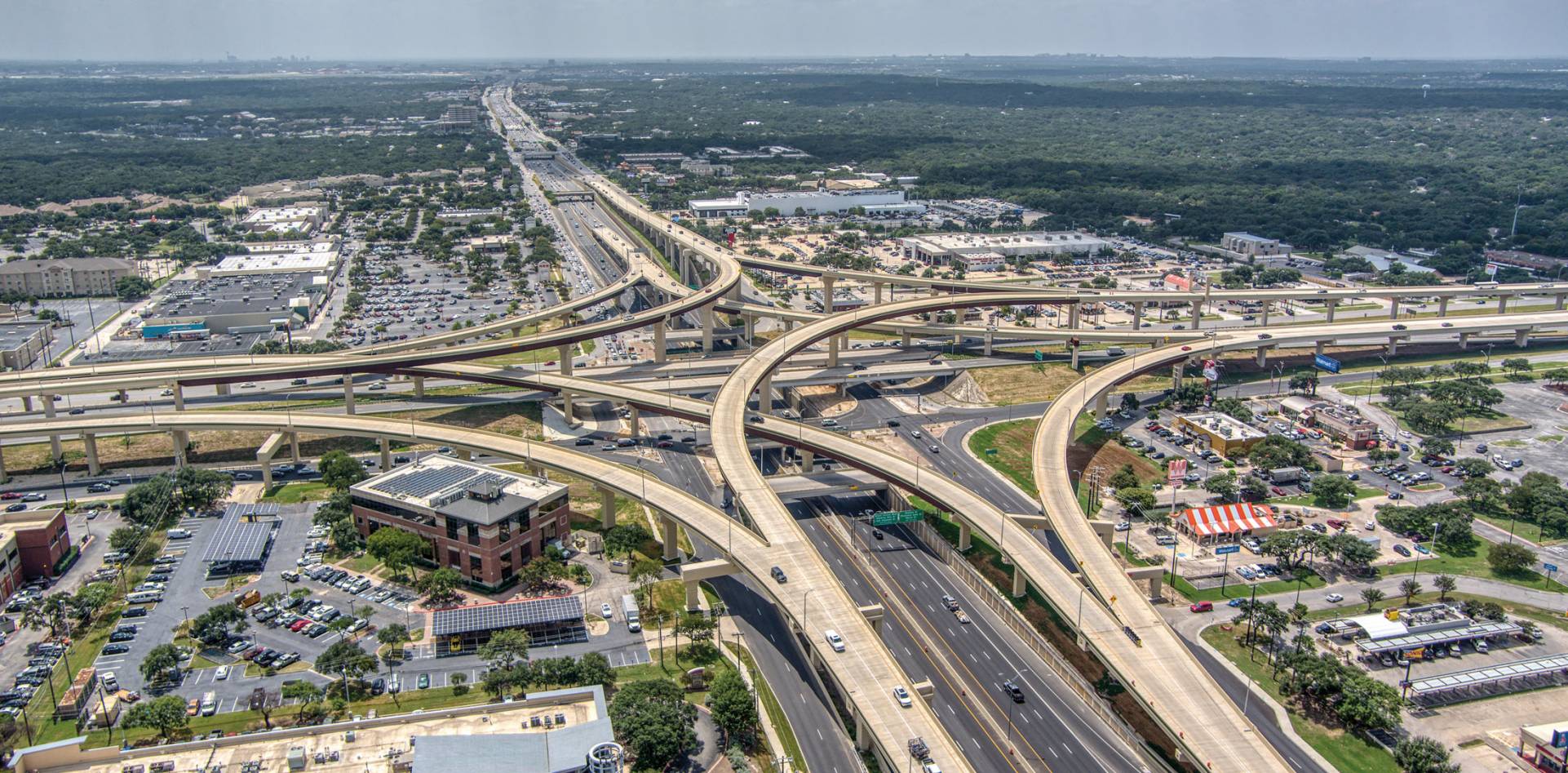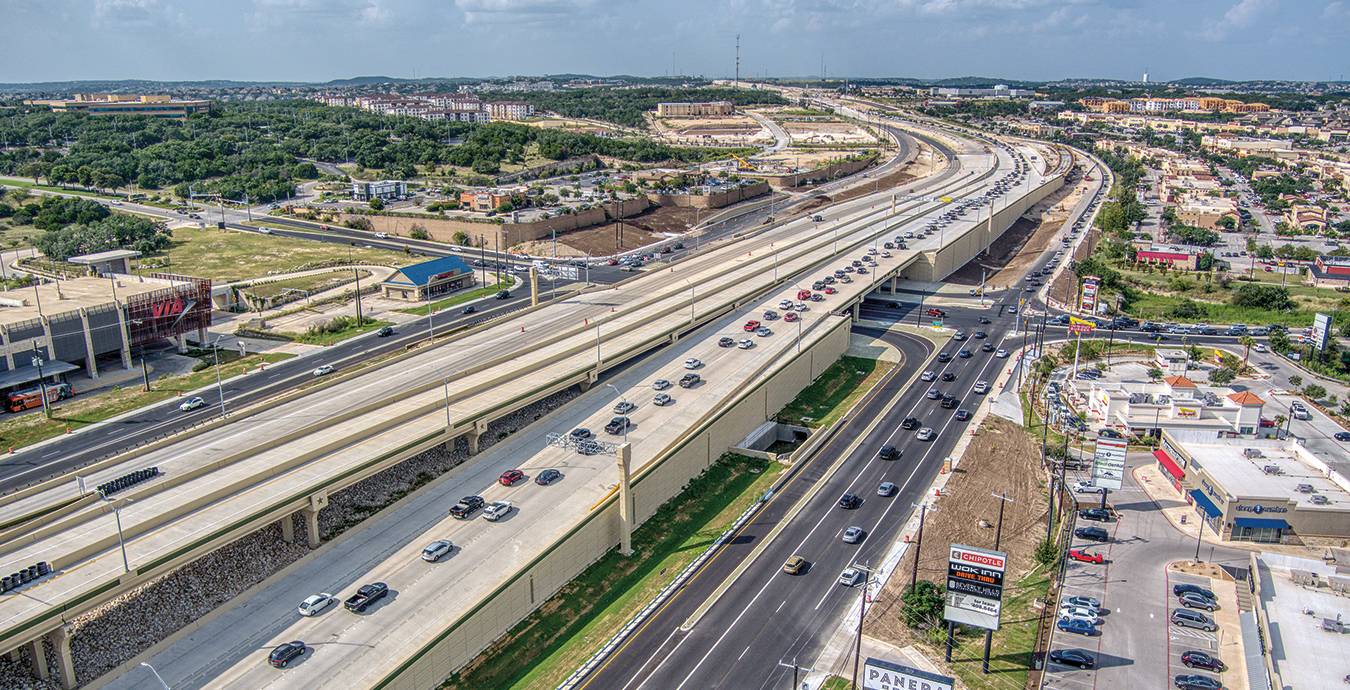
US 281’s new design balances mobility enhancements and multimodal inclusion for long-lasting improvements.
DESIGNER
2023
The combination of an aging highway system and a booming population created an increasingly untenable situation for travelers and San Antonio metropolitan region residents. It was clear a new design was needed to help the more than 100,000 vehicles traversing daily through the US 281 Corridor in northern Bexar County.
The corridor was identified as one of the most congested corridors in Texas. So much so that it’s included on the Texas Clear Lanes list of projects, an initiative launched in 2016 to address congestion in the state’s five largest metropolitan areas, including San Antonio. Altogether those areas represent more than two-thirds of the state’s population and encompass 97% of the state’s most congested roads. And revamping US 281 was going to be even more crucial in the future. The San Antonio metropolitan area was the eighth fastest growing in the U.S. in 2022, and the population is projected to grow almost 60% in less than 40 years.
Phase 1 of the project – approximately 4 miles out of an eventual eight – was completed in 2021 and the positive impact was felt immediately.
“The expansion of US 281’s north extension was transformative,” said Gina Gallegos, district engineer for the Texas Department of Transportation (TxDOT), San Antonio District. “It addressed congestion, increased mobility and multimodal options and enhanced connectivity and safety.”
Scale and Scope
US 281 Phase 1 was the expansion and conversion of almost four miles of a six- to eight-lane signalized arterial into a controlled access freeway. The project included:
- Eight non-tolled freeway lanes – four in each direction
- Two high occupancy vehicle lanes – one in each direction – between the freeway lanes and separated from the general-purpose lanes by a 4-foot buffer area, and an elevated “T” ramp connecting the HOV lanes to a new park and ride
- Four freeway-to-freeway direct connector flyover ramp
- Four overpasses
- A frontage road flyover to allow through traffic on the frontage road to bypass a signalized intersection
A myriad of challenges, stakeholders and solutions
US 281 Phase 1 included its own unique challenges, not the least of which was accommodating the daily traffic within the congested corridor.
“We also were able to maintain an innovative intersection concept that was built as an interim solution,” said Carlos Lopez, HNTB’s regional business development leader.
That was a series of Restricted Crossing U-Turns (RCUTs) created in 2010. That temporary solution, along with detailed traffic modeling, allowed for the development of a construction plan that preserved them and, with the addition of new RCUTs, allowed the project to maintain traffic flow.
“They were very helpful in keeping traffic moving through the corridor,” Lopez added.
An existing overpass at Sonterra Boulevard constrained the vertical geometry of new north and south bound connector ramps. An existing schematic called for those ramps to fly over the overpass, greatly increasing their length. HNTB roadway and structural engineers determined that moving the ramps under the overpass, instead, would avoid modifying the existing structure, meet acceptable clearances and ramp geometry, and save approximately $40 million in construction costs.
Utilities throughout the entire site presented issues, which were resolved or, in some instances, avoided altogether through HNTB’s and TxDOT’s bi-weekly meetings with the utility companies. The team also developed a utility master plan.
“The master plan documented every potential conflict in the project and what we were going to do to fix it, move it or design around it,” said Charlie Dodge, HNTB project manager. “Sometimes it meant changing our design, sometimes it meant that utilities were relocated to allow construction to proceed.”
The project also is situated over a primary source of drinking water so water quality features such as vegetative swales and filtration ponds had to be taken into consideration. In one instance original plans called for two overpasses to be artificially extended to allow construction of retention ponds underneath. A redesign by HNTB presented a more comprehensive solution that eliminated the ponds and shortened the bridges by placing the water structures between main and frontage roads at key locations. The design change resulted in significant reductions in terms of immediate costs and long-term bridge maintenance.
“The original plans for those ponds also were going to take time for environmental studies and acquisitions,” says Eddie Garcia, HNTB project controls manager. “We were able to take those ponds and find corridors to direct them away from those areas.”
Planning for the future included planning intermodal transportation. High-occupancy vehicle lanes were incorporated into the project and San Antonio’s regional public transit agency, VIA, built a multi-level park and ride and transit center facility. The projects were designed simultaneously, so the HNTB and VIA teams worked closely to match the interface between the two. VIA’s express bus service to the HOV lanes was provided by a HNTB-designed direct connection from those lanes to the park and ride facility.



Cooperation, collaboration and communication
Already one of the primary drivers of the project has been addressed. Final stats are being determined, but an early review by the Texas Transportation Institute indicates that the corridor drivers cumulatively experienced as much as 743,000 hours in annual delays can expect that figure to be cut to 380,000 hours – a reduction of nearly half.
“That was the reason that we needed to move forward on this project,” Gallegos said. “It’s already provided a multi-faceted solution to address congestion in this area.”
Scheduling for a project with such an extraordinarily high number of stakeholders is challenging enough, but the growing needs of so many demanded an accelerated timeframe. The design schedule for US 281 Phase 1 was nine months, approximately half the typical time for project of this scope. That, in turn, provided a financial benefit for TxDOT by avoiding inflation-driven construction costs.
Throughout the project the driving spirit was one of robust and enthusiastic teamwork.
“One of the highlights of this project was the overall management and team-oriented approach,” Dodge said. “It was a real partnership with TxDOT. We all agreed on a path forward and how to resolve it. At the end of the day, I’m very proud of everything we accomplished.”
“Early on we developed a communication protocol, and we maintained it throughout the entire project,” Gallegos said. “Our biggest focus was to make sure of that, because successful communication means a successful project.
Innovation Drives Recognition
The US 281 Phase 1 project has helped address the region’s immediate traffic issues, and it’s being recognized for outstanding innovation in several areas.
HNTB introduced the use of Bluebeam software to expedite submittal reviews, which was critical in meeting the nine-month design schedule. US 281 was the first project in which input, review and comments from all stakeholders were entered in the Bluebeam system. It has since become standard practice for the TxDOT San Antonio District, and HNTB was awarded a national Bluebeam Extreme Award for this project.
The project received recognition from the American Council of Engineering Companies of Texas as part of their Engineering Excellence Awards. Recognized was the team’s commitment to design and innovation that saved the client tens of millions of dollars in project and maintenance costs, enhanced that relationship and multimodal solutions.
SEE MORE ARTICLES
MORE DESIGNER STORIES
Dallas Love Field
Fish Passage
Orange Line BRT
CID Green Infrastructure Project
Denver International Airport
